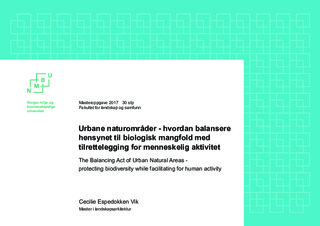| dc.contributor.advisor | Lillebye, Einar | |
| dc.contributor.author | Vik, Cecilie Espedokken | |
| dc.date.accessioned | 2017-09-11T08:49:05Z | |
| dc.date.available | 2017-09-11T08:49:05Z | |
| dc.date.issued | 2017 | |
| dc.identifier.uri | http://hdl.handle.net/11250/2453979 | |
| dc.description.abstract | Urbane naturområder har en sentral beliggenhet som gjør at de kan gi mange muligheten til å oppleve natur i nærområdet, også de som ikke vanligvis oppsøker naturområder. Denne sentrale beliggenheten gjør at de også er spesielt utsatte for friksjonen mellom naturen og mennesket, både geografisk, politisk og sosialt sett. I en verden med store miljøutfordringer, der over halvparten bor i urbane områder og har begrenset kontakt med naturen, kan urbane naturområder være avgjørende for å formidle betydningen og verdien av natur. Denne oppgaven fokuserer på å balansere hensynet til biologisk mangfold med tilrettelegging for menneskelige aktiviteter. Balansegangen illustreres gjennom et biosentrisk perspektiv, der naturen legger føringene, for så å ta opp det antroposentriske perspektivet, der menneskets nytteverdi av naturen er utgangspunktet.
Oppgaven presenterer 15 balanseprinsipper for forvaltning og utforming av urbane naturområder. Disse er fordelt på tre kategorier: Tilrettelegging for biologisk mangfold, rekreasjon og transport. Prinsippene er basert på litteratur, politiske føringer og empiriske erfaringer, som viser at et urbant naturområde best kan forvaltes ved å minimere og samle de menneskelige inngrepene. Ved å gjøre dette bevares mest mulig av naturverdiene, som er selve grunnlaget for naturopplevelser. I tillegg må det vises at naturområdet blir tatt vare på. Dette kan gjøres gjennom synliggjøring, markering, tilrettelegging, skjøtsel og informasjon.
Prinsippene blir vist brukt i Mærradalen i Oslo, som er oppgavens caseområde. Dette er en to kilometer lang bekkekløft, regulert til naturvernområde, som er mye brukt til rekreasjon og som transportåre. Her blir balanseprinsippene brukt gjennom 11 forslag til forvaltningstiltak, der hvert tiltak tar for seg ulike sammensetninger innenfor de tre kategoriene. Tiltakene vil samlet sett gi en helhetlig forvaltning av området, som tar hensyn til det biologiske mangfoldet samtidig som det tilrettelegges for menneskelig aktivitet. | nb_NO |
| dc.description.abstract | Urban natural areas have a crucial role in today’s society because of their central location. They provide the opportunity for large urban populations to experience nature, also those who do not normally seek out the wilderness. This central location makes them exposed to the friction between man and nature, with regards to both geographical -, political - and social aspects. In a world with increasing environmental problems, where over half of humanity lives in urban areas, they might be the link to reconnect urban people with nature. This thesis tries to achieve an equilibrium between the often-clashing concerns of biodiversity and human activity. This delicate balancing act is illustrated through two viewpoints: First through a biocentric perspective, where the emphasis is on the integrity of the environment, followed by an anthropocentric point of view, which focuses on the human uses and profits of natural areas.
The thesis presents 15 principles of balance for design and management of urban natural areas, based on information from literature, political guidelines and empirical findings. These principles are divided into three categories: Facilitation for biodiversity, recreation and transportation. The findings conclude that it is essential to gather and minimize the human interferences. This protects the natural values, which are the fundament for experiences of nature. Urban natural areas should also have clear signs of care, which can be done through highlighting, facilitation, management and communication.
Mærradalen in Oslo is the case area where I demonstrate how the principles can be practiced. Mærradalen is a 2-kilometre-long gorge, and a protected conservation area, which is used for recreational activities and as a transport route. The principles are used in 11 measures for improved management of the natural area. Each measure address different compositions of the principles. Together, they illustrate how the principles can be used to create a holistic management that protects the biodiversity while facilitating for human activity. | nb_NO |
| dc.language.iso | nob | nb_NO |
| dc.publisher | Norwegian University of Life Sciences, Ås | nb_NO |
| dc.rights | Attribution-NonCommercial-NoDerivatives 4.0 Internasjonal | * |
| dc.rights.uri | http://creativecommons.org/licenses/by-nc-nd/4.0/deed.no | * |
| dc.subject | Mærradalen | nb_NO |
| dc.subject | Biosentrisme | nb_NO |
| dc.subject | Antroposentrisme | nb_NO |
| dc.subject | Naturvernområder | nb_NO |
| dc.subject | Urbant friluftsliv | nb_NO |
| dc.subject | Biocentrism | nb_NO |
| dc.subject | Anthropocentrism | nb_NO |
| dc.subject | Urban protected areas | nb_NO |
| dc.subject | Urban outdoor life | nb_NO |
| dc.title | Urbane naturområder : hvordan balansere hensynet til biologisk mangfold med tilrettelegging for menneskelig aktivitet | nb_NO |
| dc.title.alternative | The balancing act of urban natural areas : protecting biodiversity while facilitating for human activity | nb_NO |
| dc.type | Master thesis | nb_NO |
| dc.subject.nsi | VDP::Humaniora: 000::Arkitektur og design: 140::Landskapsarkitektur: 147 | nb_NO |
| dc.source.pagenumber | 110 | nb_NO |
| dc.description.localcode | M-LA | nb_NO |

